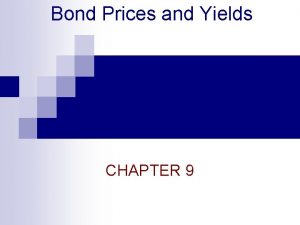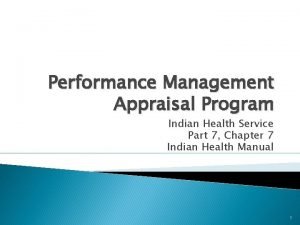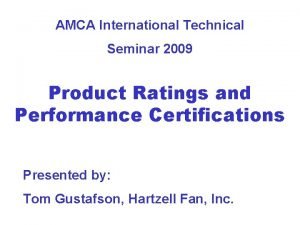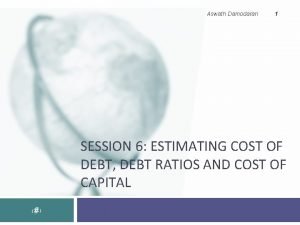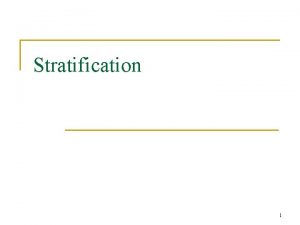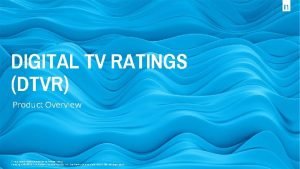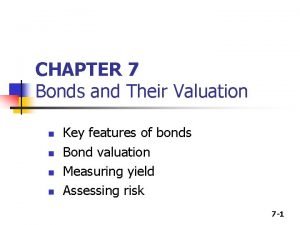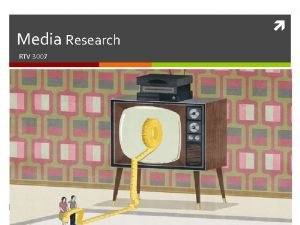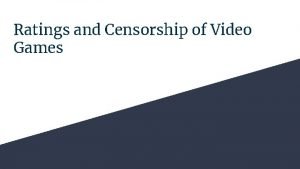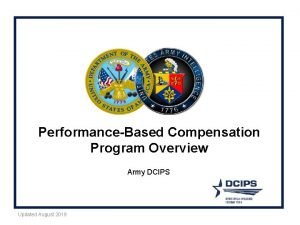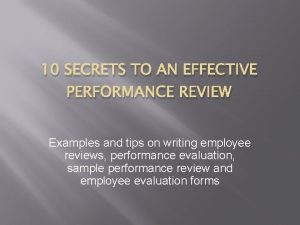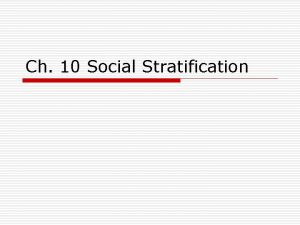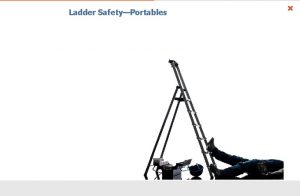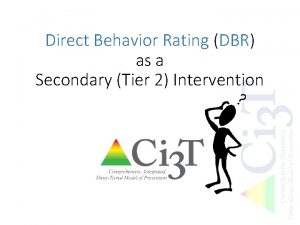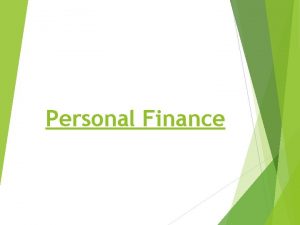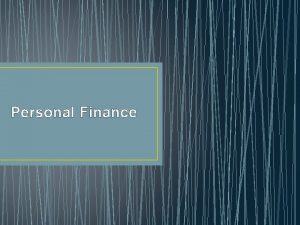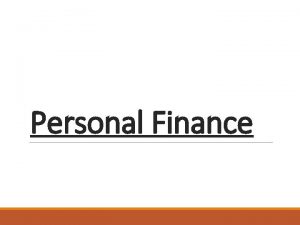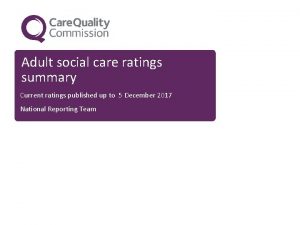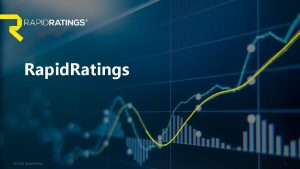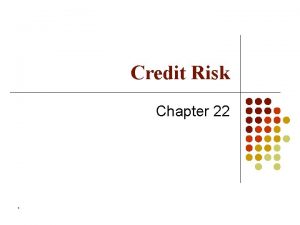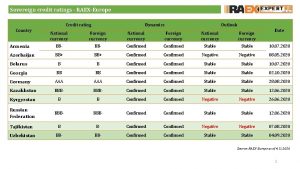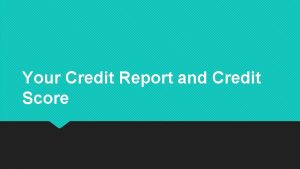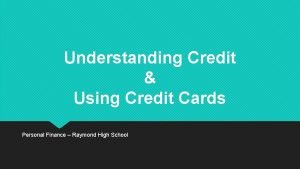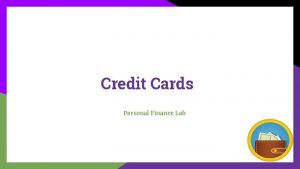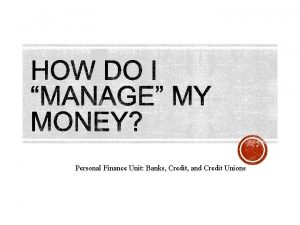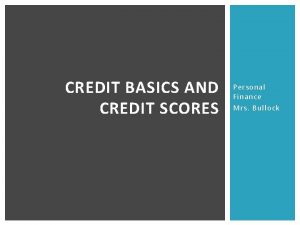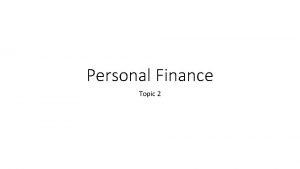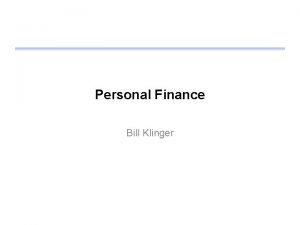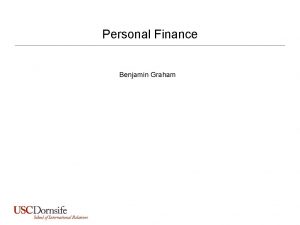Credit Ratings Personal Finance 7 02 CREDIT DEFINITIONS

























- Slides: 25

Credit Ratings Personal Finance 7. 02

CREDIT DEFINITIONS Credit Trust given to another person for future payment of a loan, credit card balance, etc. Creditor A person or company to whom a debt is owed. Debtor 2 Person owing the debt.

THE 3 Cs OF CREDIT C = Character C = Capacity C = Capital *Collateral may be needed for large purchases. 3

WHAT IS A CREDIT SCORE? 4 • A credit score is a number that helps a lender predict how likely an individual is to repay a loan, or make credit payments on time. • A credit score is a number that changes as the elements in a credit report change. • A credit score has broad use and impact. Your credit past is your credit future. • FICO® scores, one of the most common credit scoring systems, vary between 350 and 850. • Vantage. Score. SM, a new credit scoring system developed by the three credit bureaus, ranges from 501 -990.

WHAT MAKES UP A TYPICAL CREDIT SCORE? Source: Fair Isaac and Consumer Federation of America, 2005 5

IMPROVING YOUR CREDIT SCORE • • 6 Pay bills on time. Get current and stay current. Don’t open a lot of new accounts too rapidly. Correct mistakes. Shop for loan rates within a focused time period. Keep balances low on revolving credit. Pay off debt. Check your credit report.

TYPES OF CREDIT Cash Credit Sales Credit Secured Credit Revolving Credit 7 I. O. U. Single Payment Credit Installment Credit Other Types of Credit

SOURCES OF PREFERRED LENDERS Banks Retail Stores Credit Unions Credit Card Companies Insurance Policy Loans Finance Companies Savings & Loan Associations Private Loans Internet Stores What are other sources of credit? What sources of credit should be avoided? Why? 8

NON-PREFERRED LENDERS • Pay Day Lenders • Pawn Brokers • Loan Sharks These sources of credit should be avoided, because: 1. May take advantage and not fully explain terms. 2. Charge higher interest rates. 3. Seize your property/collateral. 9

STEPS TO TAKE TO AVOID ABUSIVE LENDING 1. Have you shopped around for the best deal? 2. Do you feel the lender pressured you to take the loan? 3. Do you understand the terms of the loan? 10

8 Conditions of Lending 1. 2. 3. 4. 5. 6. 7. 8. 9. 11 What is the annual fee? What is the annual percentage rate (APR)? When are payments due? What is the minimum payment required each month? Is there a grace period? Are there other fees associated with the credit, such as minimum finance charges? What is the credit limit? What are the penalties for late or missed payments? What is the method to calculate the interest?

Maintaining Good Credit Overview • Debt to income thermometer • Credit process • Credit reporting agencies • Credit safeguards for consumers • Credit reports, ratings and scores • Establishing a credit history 12

DEBT-TO-INCOME THERMOMETER 13

SAMPLE CREDIT REPORT 14

CREDIT SAFEGUARDS FOR CONSUMERS Truth In Lending Act Fair Credit Reporting Act Equal Credit Opportunity Act Fair Credit Billing Act Fair Debt Collection Practices Act 15

THE FAIR AND ACCURATE CREDIT TRANSACTION ACT One of the primary objectives behind the Fair and Accurate Credit Transaction Act (the FACT Act) is to help consumers fight the growing crime of identity theft. The following are some highlights of the Act. • • • 16 Free credit reports Fraud alerts and Active Duty alerts Truncation: credit cards, debit cards, Social Security Number Red flags Disposal of consumer reports Credit scores

THINGS TO DO TO ESTABLISH AND MAINTAIN GOOD CREDIT What can everyone do to establish and maintain good credit? 1. Pay all bills on time. 2. Avoid late fees. 3. 4. 5. 6. 17

Credit Cards Overview • Types of credit cards • Shopping for a credit card • Costs of credit 18

SHOPPING FOR A CREDIT CARD DECISIONS, DECISIONS. . . ANNUAL FEE? APR? COMPUTATION METHOD? GRACE PERIOD? FINANCE CHARGE? CREDIT LIMIT? CARD INCENTIVES? 19

7 Cautions When Seeking Loans • • 20 Read the fine print. Consider if truly needed. Bound by terms. No do-overs! Apply in person, on-line, phone, written form. Give income, work, credit history, & residence. Lender will run credit check. Right to rescission within 3 days.

COSTS OF CREDIT How much can credit cost? If you make only the minimum payment for an item, here are some examples of what you might actually pay and how long it will take you to pay it. 21

Managing Credit Challenges Overview • • 22 Warning signs of credit abuse Credit card reductions Correcting credit errors Resources and assistance

MEASURING THE SERIOUSNESS OF CREDIT TROUBLE SIGNS Rate how serious you think each of the following trouble signs is. 1 = Not Serious 4 = Very Serious Trouble Signs • • 23 Delinquent Payments Default Notices Repossessions Collection Agencies • Lien • Garnishment • Others?

WARNING SIGNS OF DEBT PROBLEMS 1. 2. 3. 4. 5. 6. 24 Delinquent Payments Default Notices Repossessions Collection Agencies Judgment Lien Garnishment

CORRECTING CREDIT PROBLEMS • • • 25 Take responsibility for actions. Communicate with creditors. Debt Consolidation Credit Counseling Bankruptcy
 Standard definitions for techniques of supply chain finance
Standard definitions for techniques of supply chain finance Standard definitions for techniques of supply chain finance
Standard definitions for techniques of supply chain finance Junk bond rating
Junk bond rating Rob sherwood receiver test
Rob sherwood receiver test Uncomfyness
Uncomfyness Pmap ratings
Pmap ratings Data center classifications
Data center classifications Demographia international housing affordability
Demographia international housing affordability Amca certification reviews
Amca certification reviews Synthetic rating damodaran
Synthetic rating damodaran Occupational prestige ratings
Occupational prestige ratings Digital tv ratings
Digital tv ratings Expected capital gains yield formula
Expected capital gains yield formula Psychodemographics
Psychodemographics Hexagon agility test average time clockwise
Hexagon agility test average time clockwise Likert summated rating adalah
Likert summated rating adalah Australian classification
Australian classification Cpars narrative examples
Cpars narrative examples Dcips quality increase
Dcips quality increase Performance ratings examples
Performance ratings examples Occupational prestige ratings
Occupational prestige ratings Governance and value creation ratings
Governance and value creation ratings Asam decision ladder
Asam decision ladder Orc club
Orc club Ladder types ratings
Ladder types ratings Direct behavior examples
Direct behavior examples


